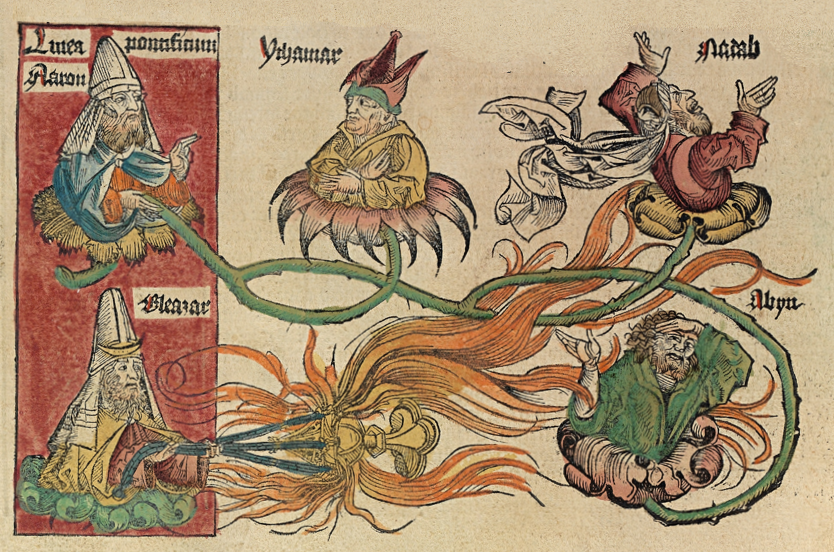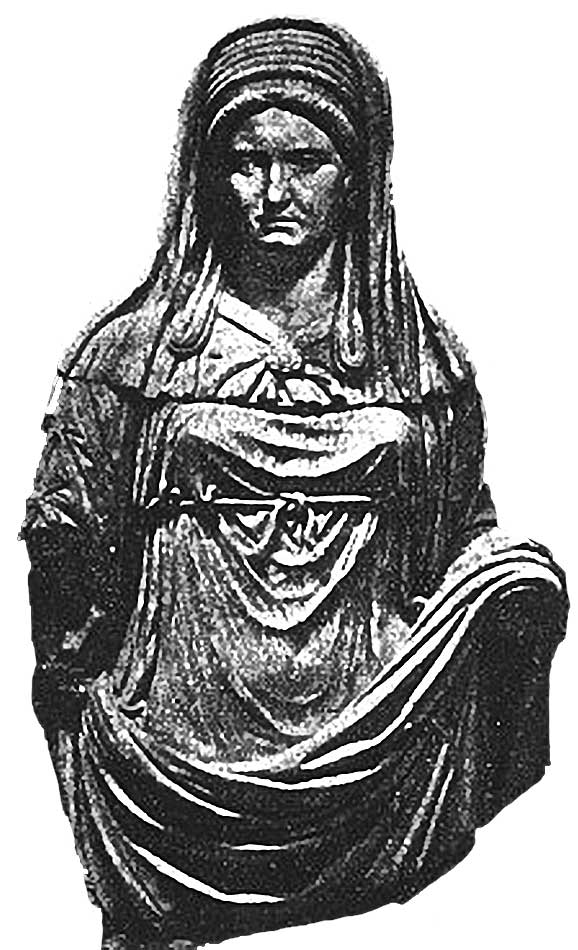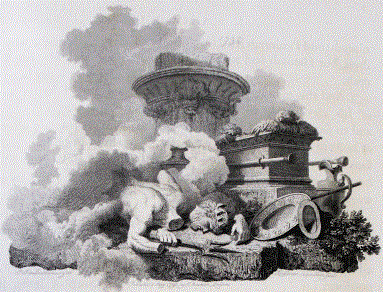|
Kohanim
Kohen (, ; , ، Arabic كاهن , Kahen) is the Hebrew word for "priest", used in reference to the Aaronic priesthood, also called Aaronites or Aaronides. They are traditionally believed, and halakhically required, to be of direct patrilineal descent from the biblical Aaron (also ''Aharon''), brother of Moses, and thus belong to the Tribe of Levi. During the existence of the Temple in Jerusalem (and previously the Tabernacle), ''kohanim'' performed the Temple sacrificial offerings, which were only permitted to be offered by them. Following its destruction, it seems that most of them joined the Synagogal Jewish movement before adopting gradually Rabbinic Judaism, other types of Judaism, Christianity or Islam. Today, ''kohanim'' retain a lesser though distinct status within Rabbinic and Karaite Judaism, including certain honors and restrictions. In the Samaritan community, the kohanim have remained the primary religious leaders. Ethiopian Jewish religious leaders are c ... [...More Info...] [...Related Items...] OR: [Wikipedia] [Google] [Baidu] |
Priest
A priest is a religious leader authorized to perform the sacred rituals of a religion, especially as a mediatory agent between humans and one or more deity, deities. They also have the authority or power to administer religious rites; in particular, rites of sacrifice to, and propitiation of, a deity or deities. Their office or position is the "priesthood", a term which also may apply to such persons collectively. A priest may have the duty to hear confessions periodically, give marriage counseling, provide prenuptial counseling, give spiritual direction, teach catechism, or visit those confined indoors, such as the sick in hospitals and nursing homes. Description According to the trifunctional hypothesis of prehistoric Proto-Indo-European society, priests have existed since the earliest of times and in the simplest societies, most likely as a result of agricultural surplus#Neolithic, agricultural surplus and consequent social stratification. The necessity to read sacred text ... [...More Info...] [...Related Items...] OR: [Wikipedia] [Google] [Baidu] |
Korban
In Judaism, the (), also spelled or , is any of a variety of sacrificial offerings described and commanded in the Torah. The plural form is , , or . The term primarily refers to sacrificial offerings given from humans to God for the purpose of doing homage, winning favor, or securing pardon. The object sacrificed was usually an animal that was ritually slaughtered and then transferred from the human to the divine realm by being burned on an altar. Other sacrifices include grain offerings made of flour and oil, not meat. After the destruction of the Second Temple, sacrifices were prohibited because there was no longer a Temple, the only place allowed by halakha for sacrifices. Offering of sacrifices was briefly reinstated during the Jewish–Roman wars of the second century CE. When sacrifices were offered in ancient times, they were offered as a fulfillment of Biblical commandments. According to Orthodox Judaism, the coming of the messiah will not remove the require ... [...More Info...] [...Related Items...] OR: [Wikipedia] [Google] [Baidu] |
Priest
A priest is a religious leader authorized to perform the sacred rituals of a religion, especially as a mediatory agent between humans and one or more deity, deities. They also have the authority or power to administer religious rites; in particular, rites of sacrifice to, and propitiation of, a deity or deities. Their office or position is the "priesthood", a term which also may apply to such persons collectively. A priest may have the duty to hear confessions periodically, give marriage counseling, provide prenuptial counseling, give spiritual direction, teach catechism, or visit those confined indoors, such as the sick in hospitals and nursing homes. Description According to the trifunctional hypothesis of prehistoric Proto-Indo-European society, priests have existed since the earliest of times and in the simplest societies, most likely as a result of agricultural surplus#Neolithic, agricultural surplus and consequent social stratification. The necessity to read sacred text ... [...More Info...] [...Related Items...] OR: [Wikipedia] [Google] [Baidu] |
Aaron
According to the Old Testament of the Bible, Aaron ( or ) was an Israelite prophet, a high priest, and the elder brother of Moses. Information about Aaron comes exclusively from religious texts, such as the Hebrew Bible, the New Testament ( Luke, Acts, and Hebrews), and the Quran. The Hebrew Bible relates that, unlike Moses, who grew up in the Egyptian royal court, Aaron and his elder sister Miriam remained with their kinsmen in the northeastern region of the Nile Delta. When Moses first confronted the Egyptian king about the enslavement of the Israelites, Aaron served as his brother's spokesman to the Pharaoh. Part of the Law given to Moses at Sinai granted Aaron the priesthood for himself and his male descendants, and he became the first High Priest of the Israelites. Levitical priests or '' kohanim'' are traditionally believed and halakhically required to be of direct patrilineal descent from Aaron. According to the Book of Numbers, Aaron died at 123 years of ... [...More Info...] [...Related Items...] OR: [Wikipedia] [Google] [Baidu] |
Yitro
Yitro, Yithro, Yisroi, Yithre, Yisrau, or Yisro (, Hebrew language, Hebrew for the name "Jethro (Bible), Jethro," the second word and incipit, first distinctive word in the parashah) is the seventeenth weekly Torah portion (, ''parashah'') in the annual Judaism, Jewish cycle of Torah reading and the fifth in the Book of Exodus. The parashah tells of Jethro's organizational counsel to Moses and God in Judaism, God's revelation of the Ten Commandments to the Israelites at Biblical Mount Sinai, Mount Sinai. The parashah constitutes Exodus 18:1–20:23. The parashah is the shortest of the weekly Torah portions in the Book of Exodus and is also one of the shortest parashot in the Torah. It is made up of 4,022 Hebrew letters, 1,105 Hebrew words, and 75 Chapters and verses of the Bible, verses. Jews read it the seventeenth Shabbat, Sabbath after Simchat Torah, generally in January or February. Jews also read part of the parashah, Exodus 19:1–20:23, as a Torah reading on the first day ... [...More Info...] [...Related Items...] OR: [Wikipedia] [Google] [Baidu] |
Mekhilta Of Rabbi Ishmael
The Mekhilta of Rabbi Ishmael ( IPA , "a collection of rules of interpretation") is midrash halakha to the Book of Exodus. The Aramaic title ''Mekhilta'' corresponds to the Mishnaic Hebrew term ' "measure," "rule", and is used to denote a compilation of exegesis ( ''middoṯ''; compare talmudical hermeneutics). Other important mekhiltas were those of Shimon bar Yochai and on Book of Deuteronomy. The latter work was also associated with Rabbi Ishmael's teachings. According to Steven Fine, both ''Sifra'' and the ''Mekhilta I.'' were concerned with the sanctification of early study houses after the destruction of the Second Temple. Authorship The author or redactor of the Mekhilta cannot be definitely ascertained. Nissim ben Jacob and Samuel ibn Naghrillah refer to it as the ''Mekhilta de-Rabbi Yishmael'', thus ascribing the authorship to Ishmael. Maimonides likewise says: "R. Ishmael interpreted from 've'eleh shemot' to the end of the Torah, and this explanation is cal ... [...More Info...] [...Related Items...] OR: [Wikipedia] [Google] [Baidu] |
Targum Yonatan
The Targum Jonathan () is the Aramaic translation of the Nevi'im section of the Hebrew Bible employed in Lower Mesopotamia ("Babylonia"). It is not to be confused with "Targum Pseudo-Jonathan," an Aramaic translation of the Torah. It is often known as "Targum Jonathan" due to a printer's error or perhaps because it is so stylistically similar to the Targum Jerusalem, which is named "Jonathan" to differentiate the two later translations. Origin Like Targum Onkelos, it originated in the synagogue reading of a translation from the Nevi'im, which was part of the weekly lesson. The Talmud attributes its authorship to Jonathan ben Uzziel, a pupil of Hillel the Elder, in Megillah 3a:4. According to this source, it was composed by Jonathan ben Uzziel "from the mouths of Haggai, Zechariah, and Malachi," implying that it was based on traditions derived from the last prophets. The additional statements that, on this account, the entire land of Israel was shaken and that a voice from ... [...More Info...] [...Related Items...] OR: [Wikipedia] [Google] [Baidu] |
Dagon
Dagon or Dagan (; ) was a god worshipped in ancient Syria, across the middle of the Euphrates, with primary temples located in Tuttul and Terqa, though many attestations of his cult come from cities such as Mari and Emar as well. In settlements situated in the upper Euphrates area, he was regarded as the "father of gods" similar to Mesopotamian Enlil or Hurrian Kumarbi, as well as a lord of the land, a god of prosperity, and a source of royal legitimacy. A large number of theophoric names, both masculine and feminine, attests that he was a popular deity. He was also worshiped further east, in Mesopotamia, where many rulers regarded him as the god capable of granting them kingship over the western areas. Attestations of Dagan from coastal areas are much less frequent and come mostly from the northern city of Ugarit, where Dagan's cult had a limited scope. According to the Hebrew Bible, Dagan was also the national god of the Philistines, with temples at Ashdod and Gaza, but ... [...More Info...] [...Related Items...] OR: [Wikipedia] [Google] [Baidu] |
Kahen
Kahen or Kohen, Kohane ( ''kahən'' "priest", plural ''kahənat'') is a religious role in Beta Israel second only to the monk or ''falasyan''. Their duty is to maintain and preserve the Haymanot among the people. This has become more difficult by the people's encounter with the modernity of Israel, where most of the Ethiopian Jewish people now live. The high priest ( ''liqa kahən'', plural ''liqanä kahhənat'') is the leader of the priests in a certain area. An aspiring kahen must spend time studying as a debtera before being ordained. As a debtera, he will be closer to the laypeople and serve as an intermediary between them and the clergy. Upon becoming a kahen, he will no longer perform the services of a debtera, though he may take them up again if he gives up his position or is deposed.Isaac Greenfield, "The Debtera and the education among Ethiopian Jewry until the arrival of Dr. Faitlovitch" in Menachem Waldman (ed.), ''Studies in the History of Ethiopian Jews'', Haberma ... [...More Info...] [...Related Items...] OR: [Wikipedia] [Google] [Baidu] |
Nuremberg Chronicles F 29v 2
Nuremberg (, ; ; in the local East Franconian dialect: ''Nämberch'' ) is the Franconia#Towns and cities, largest city in Franconia, the List of cities in Bavaria by population, second-largest city in the States of Germany, German state of Bavaria, and its 544,414 (2023) inhabitants make it the List of cities in Germany by population, 14th-largest city in Germany. Nuremberg sits on the Pegnitz (river), Pegnitz, which carries the name Regnitz from its confluence with the Rednitz in Fürth onwards (), and on the Rhine–Main–Danube Canal, that connects the North Sea to the Black Sea. Lying in the Bavarian Regierungsbezirk, administrative region of Middle Franconia, it is the largest city and unofficial capital of the entire cultural region of Franconia. The city is surrounded on three sides by the , a large forest, and in the north lies (''garlic land''), an extensive vegetable growing area and cultural landscape. The city forms a continuous conurbation with the neighbouring ... [...More Info...] [...Related Items...] OR: [Wikipedia] [Google] [Baidu] |
Hebrew Bible
The Hebrew Bible or Tanakh (;"Tanach" . '' Random House Webster's Unabridged Dictionary''. ; ; or ), also known in Hebrew as (; ), is the canonical collection of scriptures, comprising the Torah (the five Books of Moses), the Nevi'im (the Books of the Prophets), and the [...More Info...] [...Related Items...] OR: [Wikipedia] [Google] [Baidu] |
Noun
In grammar, a noun is a word that represents a concrete or abstract thing, like living creatures, places, actions, qualities, states of existence, and ideas. A noun may serve as an Object (grammar), object or Subject (grammar), subject within a phrase, clause, or sentence.Example nouns for: * Living creatures (including people, alive, dead, or imaginary): ''mushrooms, dogs, Afro-Caribbeans, rosebushes, Mandela, bacteria, Klingons'', etc. * Physical objects: ''hammers, pencils, Earth, guitars, atoms, stones, boots, shadows'', etc. * Places: ''closets, temples, rivers, Antarctica, houses, Uluru, utopia'', etc. * Actions of individuals or groups: ''swimming, exercises, cough, explosions, flight, electrification, embezzlement'', etc. * Physical qualities: ''colors, lengths, porosity, weights, roundness, symmetry, solidity,'' etc. * Mental or bodily states: ''jealousy, sleep, joy, headache, confusion'', etc. In linguistics, nouns constitute a lexical category (part of speech) defined ... [...More Info...] [...Related Items...] OR: [Wikipedia] [Google] [Baidu] |







